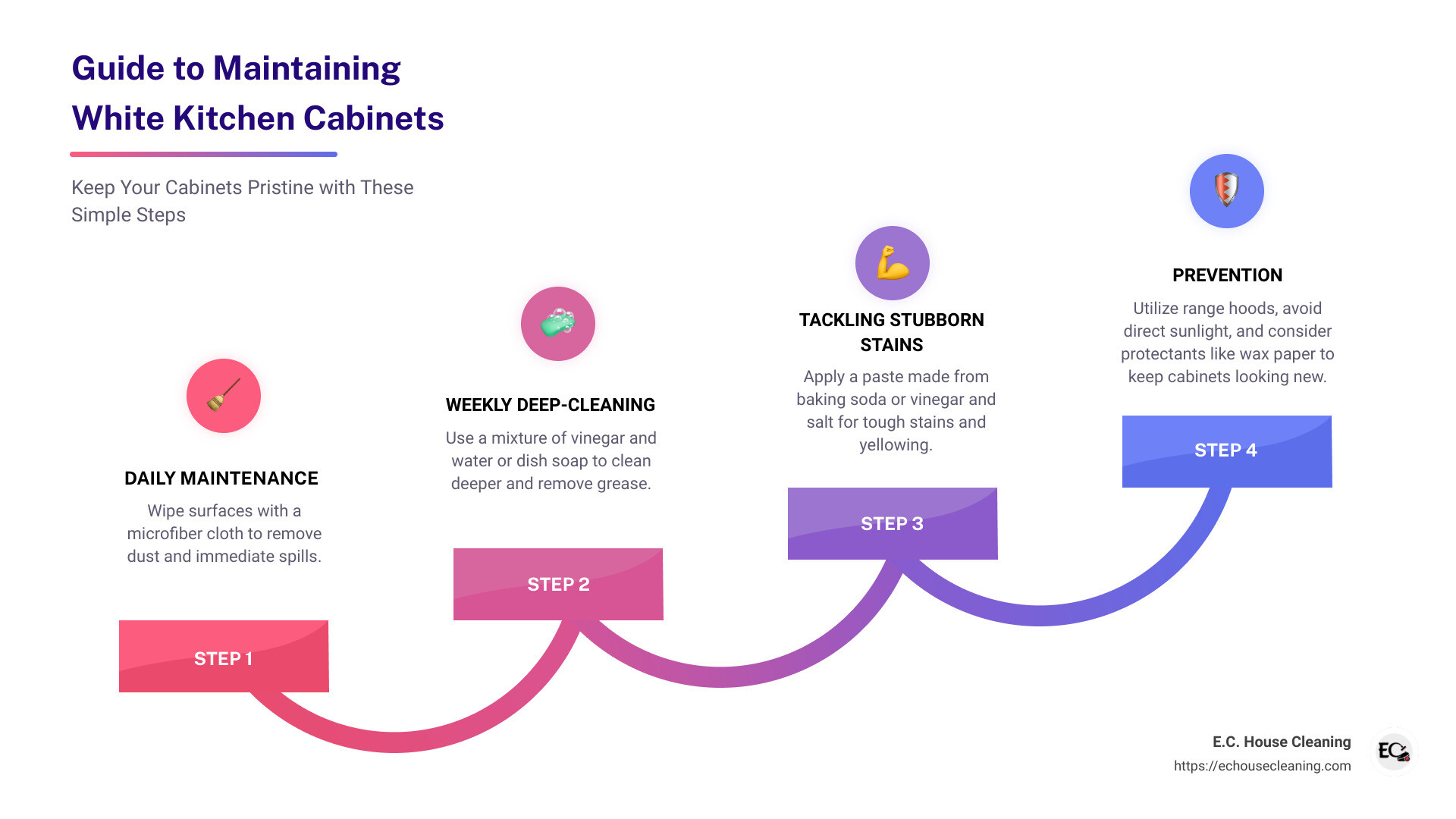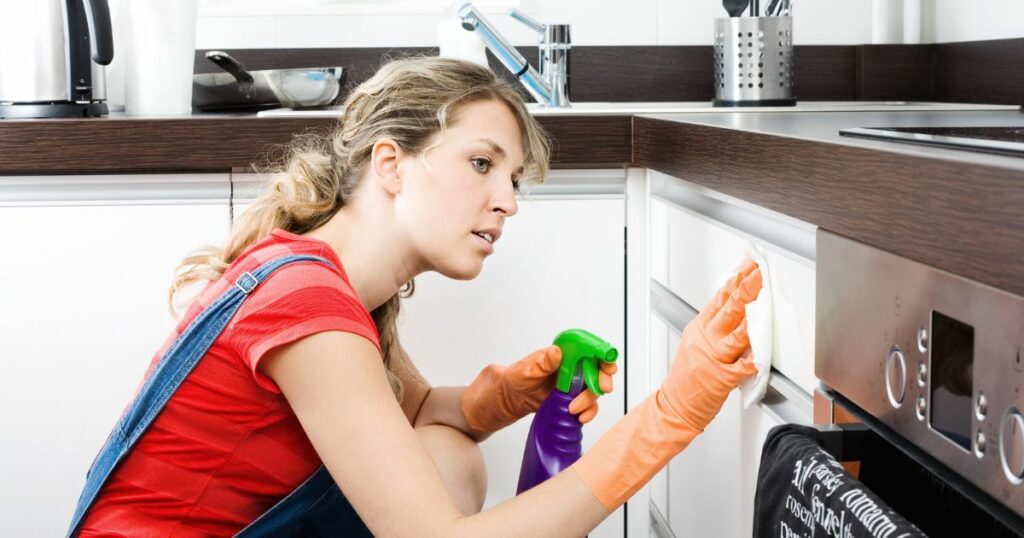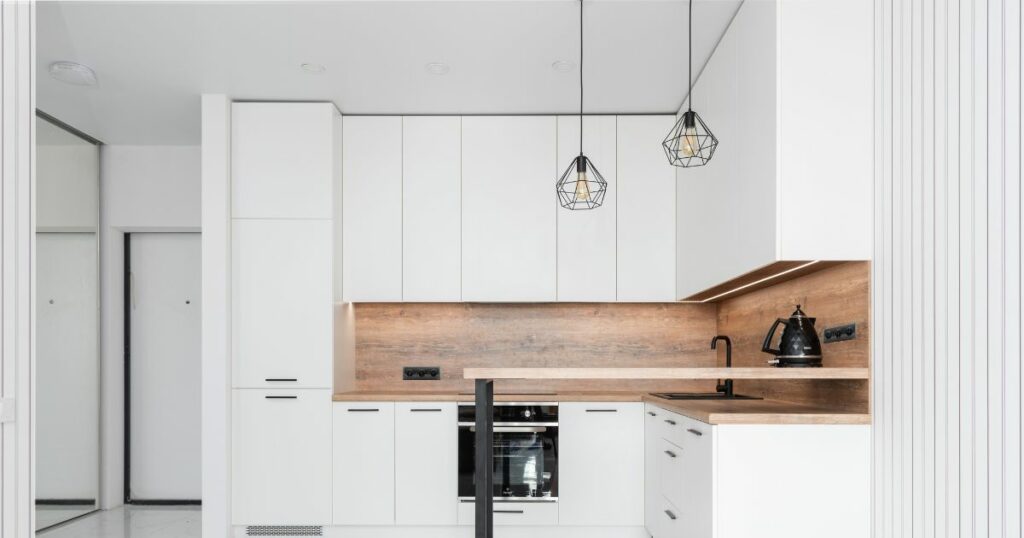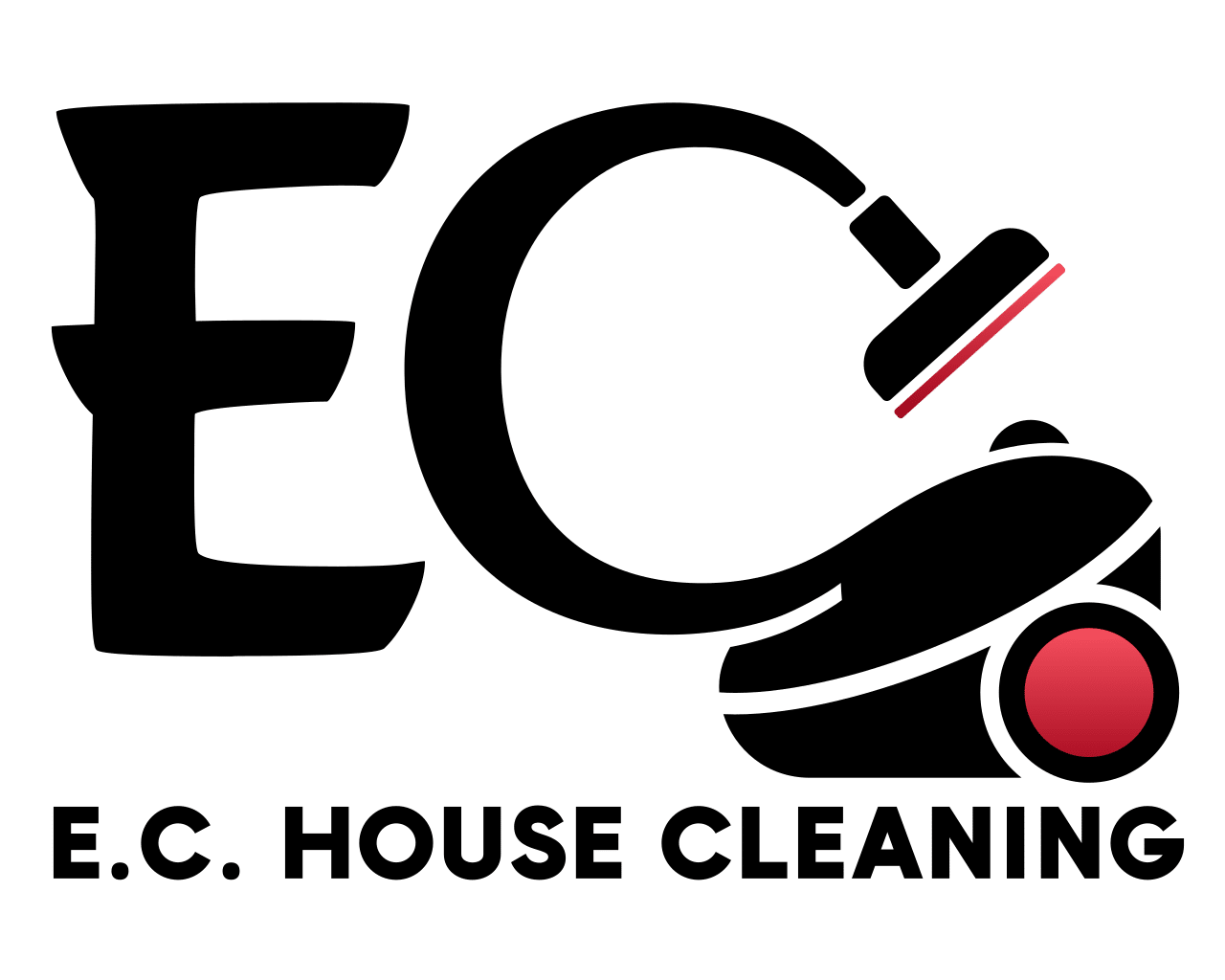White kitchen cabinets can be the centerpiece of a home, offering a bright and welcoming atmosphere. However, they also show dirt and stains more easily than darker cabinets, which can be a challenge for busy Massachusetts professionals and families who value cleanliness but might not have time for constant upkeep.
This introduction to cleaning white kitchen cabinets is designed to help simplify this task, offering straightforward methods to maintain their pristine appearance without sacrificing your time or compromising on health and environmental standards.
How to Clean White Kitchen Cabinets
How to clean white kitchen cabinets effectively starts with understanding that regular maintenance is key to keeping them looking their best. Here’s a swift guide to get you started:
- Daily: Wipe surfaces with a microfiber cloth to remove dust and prevent buildup.
- Weekly: Use a mixture of vinegar and water or dish soap for a deeper clean.
- As Needed: Tackle stubborn stains with a paste made from baking soda or vinegar and salt.
- Prevention: Utilize range hoods and avoid direct sunlight to protect the cabinets.

Table of Contents
Daily Maintenance for White Kitchen Cabinets
Keeping your white kitchen cabinets clean doesn’t have to be a daunting task. With some simple daily maintenance habits, you can ensure they stay bright and fresh without requiring hours of your time. Here’s how:
Use a Microfiber Cloth
A microfiber cloth is your best friend when it comes to daily cabinet care. These cloths are gentle on surfaces but effective at picking up dust, dirt, and fingerprints. Just a quick wipe over the doors and handles every day can make a big difference. The goal is to prevent buildup, making deeper cleans easier and less frequent.
Tackle Spills and Food Splashes Immediately
Spills and splashes are inevitable, especially in a bustling kitchen. However, the key to maintaining spotless white cabinets is addressing these messes right away. Whether it’s tomato sauce, grape juice, or a splash of coffee, use a damp microfiber cloth to wipe it up as soon as it happens. This immediate action prevents stains from setting in and saves you from a lot of scrubbing later on.
- For oil splatters, a mix of dish soap and water on your cloth can cut through the grease.
- For sticky substances, a bit of warm water should dissolve the residue enough for easy wiping.
Preventive Measures Are Key
In addition to dealing with spills and splashes promptly, some preventive measures can help keep your cabinets looking their best:
- Cook with care: When frying or cooking something that splatters, use a splatter screen. It’s a simple tool but can save you a lot of cleaning time.
- Use exhaust fans: Always turn on your kitchen’s exhaust fan while cooking. This helps to draw away steam and grease particles that might otherwise settle on your cabinets.
In Summary
Daily maintenance for white kitchen cabinets is all about being proactive. A microfiber cloth for dusting, immediate attention to spills and splashes, and some preventive measures during cooking can keep your cabinets looking their best. This way, you maintain a clean, bright kitchen without the need for time-consuming deep cleans. A little effort every day goes a long way in keeping your white cabinets pristine and welcoming.
Following these simple steps will ensure your kitchen remains a place of beauty and cleanliness, reflecting your personal standards and making every cooking experience enjoyable. Stay tuned for our next section on Weekly Deep-Cleaning Strategies to take your cabinet care to the next level.
Weekly Deep-Cleaning Strategies

After establishing a routine for daily maintenance, setting aside time for a weekly deep-clean can elevate the condition of your white kitchen cabinets, ensuring they remain in top shape. It’s crucial to pay special attention to the cabinet door during this process, as it often faces the brunt of kitchen grime. Here’s how to tackle this task effectively using vinegar and water, dish soap, and baking soda. After applying the vinegar and water solution, use a dry microfiber cloth to dry the cabinets thoroughly, ensuring no moisture remains that could damage the wood over time.
Vinegar and Water: The Natural Cleaner
Mix equal parts of white vinegar and water in a spray bottle. Vinegar is a natural disinfectant and deodorizer, making it perfect for cleaning without leaving harmful residues behind. Spray the solution onto the cabinet surfaces, let it sit for a few minutes to break down grease and grime, then wipe clean with a microfiber cloth. This method is especially useful for removing light stains and refreshing your cabinets without the use of harsh chemicals.
Dish Soap: Cutting Through Grease
For areas with heavier grease buildup, a solution of warm water and a few drops of dish soap works wonders. Dish soap is designed to cut through grease and leave surfaces clean and streak-free. Dip a soft cloth or sponge in the soapy water, wring it out, and gently scrub the cabinets. Pay special attention to handles and around knobs where grease accumulates. Rinse the cloth with clean water, and wipe off any soap residue to avoid leaving marks.
Baking Soda: The Stubborn Stain Remover
Stubborn stains and yellowing can be addressed with a paste made from baking soda and water. Baking soda is mildly abrasive, making it effective at removing stuck-on stains without scratching the cabinet surface. Apply the paste directly to the stains, let it sit for a few minutes, then gently scrub with a soft cloth or sponge. Rinse thoroughly and dry with a clean cloth. This method is particularly useful for tackling those tough spots that daily cleaning can’t resolve.
Weekly Checklist:
- Vinegar and Water Spray: Use for a quick, overall refresh.
- Soapy Water Scrub: Focus on greasy areas and handles.
- Baking Soda Paste: Apply to stubborn stains and yellowed spots.
By incorporating these strategies into your weekly cleaning routine, you’ll ensure your white kitchen cabinets stay bright, clean, and free of buildup. It’s the balance of gentle, routine care and targeted deep-cleaning that maintains the pristine appearance of your cabinets over time.
We’ll explore Preventive Measures to Keep Cabinets Pristine, offering tips to avoid damage and reduce the need for frequent deep cleans. Stay with us to learn how to protect and preserve the beauty of your white kitchen cabinets with ease.
Tackling Stubborn Stains and Yellowing

Dealing with stubborn stains and yellowing on white kitchen cabinets can feel like a battle. But, with the right approach, it’s a battle you can win. Let’s dive into three effective methods: vinegar & salt paste, baking soda paste, and the eraser method.
When it comes to painted cabinets, it’s crucial to employ gentle cleaning techniques to avoid damaging the paint while effectively removing stains and yellowing. Regular maintenance and careful cleaning are key to preserving the pristine condition of painted surfaces without causing scratches or harm to the finish.
Vinegar & Salt Paste
A simple yet powerful solution is creating a paste using vinegar and salt. Mix equal parts until you get a thick consistency. Apply this paste directly to the stained or yellowed areas of your cabinets. Let it sit for a few minutes to work its magic. The acidity of the vinegar cuts through the grime, while the salt acts as a gentle abrasive to scrub away the stain. Afterward, rinse with warm water and dry thoroughly. This method is especially useful for light stains and general yellowing.
Baking Soda Paste
For tougher stains, a baking soda paste may be your best friend. Combine baking soda with water to create a thick paste. Gently apply this to the stains on your cabinets and let it sit for a few minutes. Baking soda is a natural cleaning agent that not only cleans but also deodorizes, leaving your cabinets looking and smelling fresh. Use a soft cloth or sponge to scrub the paste in a circular motion, then rinse with water and dry. This method is great for more stubborn stains that the vinegar and salt paste might not fully remove.
Eraser Method
Sometimes, you may encounter scuffs or marks that seem immune to liquid solutions. In these cases, consider the eraser method. A magic eraser can be lightly dampened and then used to gently rub away marks. The micro-scrubbers within magic erasers can lift away grime without the need for harsh chemicals. However, always test a small, inconspicuous area first to ensure it doesn’t damage the finish of your cabinets.
By incorporating these techniques into your cleaning routine, you’ll tackle even the most stubborn stains and yellowing on your white kitchen cabinets. Patience and gentle, consistent effort are key. Harsh scrubbing can damage the cabinet’s surface, so always start with the gentlest method and work your way up as needed.
We’ll delve into Preventive Measures to Keep Cabinets Pristine. Protecting your cabinets from damage and reducing the frequency of deep cleans will not only keep them looking their best but also extend their lifespan. Stay tuned for tips on how to maintain the beauty and integrity of your white kitchen cabinets with minimal effort.
Preventive Measures to Keep Cabinets Pristine

To maintain the beauty and integrity of your white kitchen cabinets without breaking a sweat, it’s crucial to take preventive measures. By implementing simple strategies, you can keep your cabinets looking fresh and minimize the need for frequent deep cleaning. Let’s explore how to protect your cabinets effectively.
For those with glass cabinets, special attention is needed to maintain their clear and streak-free appearance. It’s important to avoid oil-based cleaners, as they can leave residue and streaks on the glass and potentially harm the adjacent cabinet material. Instead, opt for gentle cleaning solutions designed for glass to keep these cabinets looking their best.
Use Your Range Hood
Whenever you cook, turn on your range hood. This simple action can make a big difference. It helps to remove smoke, grease, and cooking odors from the air before they settle on your cabinets. Keeping these particles away from your cabinets prevents them from becoming grimy and discolored.
Avoid Direct Sunlight
Direct sunlight can be an enemy to your white kitchen cabinets, causing them to yellow over time. To protect your cabinets, consider using curtains or blinds to block or filter sunlight during the peak hours of the day. If your kitchen layout permits, try to position your cabinets away from direct sunlight.
Line Shelves and Drawers with Wax Paper
An often overlooked trick is lining your shelves and drawers with wax paper. This barrier can catch spills, crumbs, and dust, making cleanup a breeze. Simply replace the wax paper as needed, and you’ll find your cabinets stay cleaner for longer.
Turn On Your Exhaust Fan
Similar to using the range hood, turning on your exhaust fan can help maintain a cleaner environment for your white cabinets. The exhaust fan helps to reduce humidity and moisture in the kitchen, which can be particularly beneficial after cooking or dishwashing. This step is crucial in preventing mold growth and protecting cabinets from moisture damage.
By incorporating these preventive measures into your daily routine, you can significantly reduce the amount of dirt and grime that accumulates on your white kitchen cabinets. Not only do these steps help in maintaining the pristine appearance of your cabinets, but they also extend their lifespan, ensuring that your kitchen remains a bright and welcoming space for years to come.
Next, we’ll shift our focus to Eco-Friendly Cleaning Solutions. Embracing natural cleaning methods not only benefits the environment but also ensures the safety and longevity of your kitchen cabinets. Stay tuned for tips on creating effective, natural cleaners that pack a punch without the harsh chemicals.
Eco-Friendly Cleaning Solutions
When it comes to keeping your white kitchen cabinets shining, turning to nature can offer some of the best solutions. Not only do these methods safeguard your health and the environment, but they also deliver impressive results. Let’s dive into how you can harness the power of eco-friendly cleaning solutions.
DIY Cleaning Products
Creating your own cleaning products is easier than you might think, and you likely already have everything you need. A simple mix of vinegar and water can work wonders for wiping away grease and grime. For a basic cleaner, mix equal parts of water and white vinegar in a spray bottle. This solution is perfect for a quick refresh or a deep clean, depending on your needs.
For tougher stains, a paste made from baking soda and water can be applied directly to the affected area. Let it sit for a few minutes, then gently scrub away the stain. Baking soda is a mild abrasive, which means it can tackle tough stains without scratching your cabinets.
Natural Cleaning Power
The natural acidity in vinegar makes it a powerful cleaner, capable of dissolving grease, soap scum, and hard water stains. It’s also effective at killing bacteria, mold, and germs, thanks to its acidic nature. However, its smell can be a bit strong for some. If that’s the case, consider adding a few drops of your favorite essential oils to your cleaning mix to leave a fresh, pleasant scent behind.
Citrus Multipurpose Cleaner
For a zesty twist, citrus peels can be infused with vinegar to create a potent multipurpose cleaner. Simply fill a jar with citrus peels (lemon, lime, orange, or grapefruit work well), then pour white vinegar over them. Seal the jar and let it sit for a couple of weeks. Strain the vinegar into a spray bottle, dilute with water, and you have a powerful cleaner that smells great and works hard. This citrus-infused vinegar is especially good at cutting through grease and leaving a streak-free shine.
Eco-friendly cleaning solutions are not just about keeping your white kitchen cabinets looking their best; they’re also about creating a healthier home and planet. By choosing to make your own cleaners, you’re reducing plastic waste and avoiding the toxic chemicals found in many commercial products.
Remember that regular maintenance combined with these natural cleaning solutions will keep your white kitchen cabinets in top condition. With a little effort and some eco-friendly practices, you can enjoy a clean, bright kitchen that’s as welcoming as it is beautiful.
Long-Term Care and Maintenance

Keeping your white kitchen cabinets clean and bright is not just a task; it’s a commitment. Like any good relationship, it requires regular attention, a bit of care, and the right approach to maintenance. Let’s dive into how regular maintenance, using beeswax-based products, and preventing grease buildup can make a world of difference.
Regular Maintenance
Think of regular maintenance as the daily exercise routine for your cabinets. Just as staying active keeps you healthy, regular cleaning keeps your cabinets in pristine condition. Here’s the simple plan:
- Weekly Wipe-Downs: Using a microfiber cloth, give your cabinets a gentle wipe every week. This prevents dust and grease from building up and making themselves at home.
- Monthly Deep Clean: Once a month, mix up your natural cleaning solution (remember the vinegar and water?) and give your cabinets a thorough cleaning. Pay special attention to handles and corners where grease and grime like to hide.
Beeswax-Based Products
Now, let’s talk about nourishment. Just like your skin benefits from moisturizer, your wood cabinets thrive with a bit of beeswax-based product love. Here’s why:
- Moisture Lock: Beeswax forms a protective barrier that locks in moisture, keeping the wood from drying out and cracking.
- Natural Shine: It leaves your cabinets with a natural, healthy glow without the need for harsh chemicals.
- Long-Lasting Protection: This barrier also protects against stains and makes future cleaning easier.
Apply a thin layer of beeswax polish with a soft cloth, gently buffing it into the wood. It’s like giving your cabinets a spa day, and who doesn’t love that?
Grease Buildup Prevention
Grease is the nemesis of white kitchen cabinets. It’s sneaky, persistent, and can make your cabinets look dull over time. But fear not, here are some strategies to keep it at bay:
- Use Your Range Hood: Every time you cook, turn on your range hood. It sucks up grease particles that would otherwise end up on your cabinets.
- Cover Pots and Pans: When frying or sautéing, cover your cookware to minimize splatters.
- Exhaust Fans Are Friends: If you have an exhaust fan, use it. It helps reduce overall grease in the air.
Incorporating these habits into your kitchen routine can significantly reduce grease buildup, making those weekly wipe-downs and monthly deep cleans even more effective.
By embracing regular maintenance, treating your cabinets to beeswax-based products, and preventing grease before it starts, you’re setting the stage for long-term beauty and durability. The goal is not just about keeping your white kitchen cabinets looking their best; it’s about creating a space that feels good to live in. And with a little effort, that’s exactly what you’ll have.
Conclusion
We’ve walked through the essentials of keeping your white kitchen cabinets in top shape, from the daily wipe-downs to the deeper cleans, and even how to tackle those stubborn stains and yellowing. But, what ties all these efforts together is a commitment to regular care and the right approach to cleaning.
The beauty of your white kitchen cabinets isn’t just in their initial appeal but in their sustained cleanliness and brightness. Incorporating the right cleaning habits, using eco-friendly products, and seeking professional help when needed is key.
Let us be part of your journey in maintaining a pristine kitchen. Our expertise and commitment to eco-friendly practices ensure that your white cabinets, and your entire home, are not only clean but cared for with the utmost respect for your health and the environment.
In closing, mastering how to clean white kitchen cabinets is more than just about the cleaning itself; it’s about embracing a routine that values sustainability, health, and the long-term beauty of your home. At E.C. House Cleaning, we’re here to help you achieve just that. Together, we can keep your white kitchen cabinets—and your entire home—looking its best for years to come.
Contact us today at E.C. House Cleaning, we understand the importance of this commitment. Our house cleaning services in Massachusetts are designed to support you in maintaining not just your white kitchen cabinets but your entire home’s cleanliness and appeal. We believe in the power of eco-friendly cleaning solutions and the impact they have on preserving the beauty of your home while keeping your environment safe and healthy.
Our Content
All content is written by E.C. House Cleaning’s professional cleaning company for Boston Maid Service. We put our expertise in house cleaning services into each piece of content, focusing on providing valuable, accurate, and relevant information. With over 20 years of deep, full cleaning service industry experience in the Massachusetts and Boston area with a proven track record of pet-friendly cleaning services in Massachusetts, green cleaning maid service, residential deep cleaning, Massachusetts attic cleaning, and trust for customers as signaled by our hundreds of 5-star reviews, E.C. House Cleaning is an authority on residential and commercial cleaning services.1
